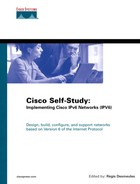Chapter 6. IPv6 Hosts Internetworking with Cisco
“640K is enough for anybody.”
—Bill Gates, 1981
As you saw in Chapter 2, “IPv6 Addressing,” the built-in stateless autoconfiguration mechanism in IPv6 allows nodes on local links to configure their IPv6 addresses by themselves. Chapter 5, “IPv6 Integration and Coexistence Strategies,” described the transition and coexistence mechanisms used to move your current IPv4 network infrastructures toward IPv6. Both chapters discussed the interactions between the routers and IPv6 nodes deployed on networks.
The primary objective of this chapter is to show you how to enable and configure IPv6 support on the most common host operating systems, such as Microsoft Windows, Solaris, FreeBSD, Linux, and Tru64 when deploying IPv6 over networks with Cisco routers.
This chapter also explains how to enable stateless autoconfiguration on these host implementations and how they interact with Cisco routers using transition and coexistence mechanisms such as configured tunnel and 6to4.
After completing this chapter, you will be able to configure and manage Microsoft Windows NT, Microsoft Windows 2000, Microsoft Windows XP, Solaris 8, FreeBSD 4.x, Linux, and Tru64 with IPv6 support. This chapter also presents examples of host and router configurations with IPv6.
